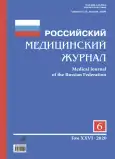Occupational burnout of healthcare workers: personal deadaptation or system failure in management?
- Authors: Karsanov A.M.1, Remizov O.V.1, Goluchov G.N.2, Polunina N.V.2
-
Affiliations:
- North-Ossetian State Medical Academy
- N.I. Pirogov Russian National Research Medical University
- Issue: Vol 26, No 6 (2020)
- Pages: 334-340
- Section: Health care organization and public health
- URL: https://journals.rcsi.science/0869-2106/article/view/65009
- DOI: https://doi.org/10.17816/0869-2106-2020-26-6-334-340
- ID: 65009
Cite item
Abstract
The article presents modern data on definitive characteristics, causes of occurrence, phases of development, principles of a systematic approach to prevention, and methods to overcome such a complex concept as occupational burnout of healthcare workers. Occupational burnout has serious negative consequences for not only the health of the health workers themselves but also the effective functioning of the entire healthcare system. In this regard, some discrepancies in the conjugation of internal and external stimulants are considered to improve the efficiency of the work of medical personnel. Lessons learned from the coronavirus 2019 pandemic as a factor of healthcare system overloading and triggering occupational burnout necessitate creation of a multi-stage, systemic mechanism to protect our colleagues as well as patients from the consequences of occupational burnout.
Full Text
##article.viewOnOriginalSite##About the authors
Alan M. Karsanov
North-Ossetian State Medical Academy
Author for correspondence.
Email: karsan@inbox.ru
ORCID iD: 0000-0001-8977-6179
MD, PhD
Russian Federation, 362025, VladikavkazOleg V. Remizov
North-Ossetian State Medical Academy
Email: oleg_remizov@mail.ru
ORCID iD: 0000-0003-4175-5365
MD, PhD, DSc
Russian Federation, 362025, VladikavkazGeorgiy N. Goluchov
N.I. Pirogov Russian National Research Medical University
Email: 7648616@gmail.com
MD, PhD, DSc, Corresponding Member of RAS, Professor
Russian Federation, 117997, MoscowNatalia V. Polunina
N.I. Pirogov Russian National Research Medical University
Email: nvpol@rambler.ru
ORCID iD: 0000-0001-8772-4631
MD, PhD, DSc, Academician of RAS, Professor
Russian Federation, 117997, MoscowReferences
- Wu Y, Wang J, Luo C, Hu S, Lin X, Anderson AE, et al. A comparison of burnout frequency among oncology physicians and nurses working on the front lines and usual wards during the COVID-19 epidemic in Wuhan, China. J. Pain Symptom Manage. 2020;60(1): 60–65. doi: 10.1016/j.jpainsymman.2020.04.008.
- Matyushkina EYa, Mikita OYu, Holmogorova AB. Burnout level in medical residents doing internship in emergency medicine hospital before the pandemic. Konsultativnaya psihologiya i psihoterapiya. 2020;(2):46–69. (In Russ).
- Hartzband P, Groopman J. Physician burnout, interrupted. N Engl J Med. 2020;382(26):2485–248. doi: 10.1056/NEJMp2003149.
- Panagioti M, Geraghty K, Johnson J, Zhou A, Panagopoulou E, Chew-Graham C, et al. Association between physician burnout and patient safety, professionalism, and patient satisfaction: a systematic review and meta-analysis. JAMA Intern. Med. 2018;178(10):1317–1330. doi: 10.1001/jamainternmed.2018.3713.
- Wallace JE, Lemaire JB, Ghali WA. Physician wellness: a missing quality indicator. Lancet. 2009;374(9702):1714–1721. doi: 10.1016/S0140-6736(09)61424-0.
- Spickard AJr, Gabbe SG, Christensen JF. Mid-career burnout in generalist and specialist physicians. JAMA. 2002;288(12):1447–1450. doi: 10.1001/jama.288.12.1447.
- Burisch M. Das Burnout-Syndrom: Theorie der inneren Erschöpfung. Springer-Verlag; 2013. 262 p. (In German).
- Klein J, Grosse Frie K, Blum K, von dem Knesebeck O. Burnout and perceived quality of care among German clinicians in surgery. Int. J. Qual. Health Care. 2010;14(6):525–530.
- Shanafelt TD, Hasan O, Dyrbye LN, Sinsky C, Salete D, Sloan J, et al. Changes in burnout and satisfaction with work-life balance in physicians and the general US working population between 2011 and 2014. Mayo Clin. Proc. 2015;90(12):1600–1613. doi: 10.1016/j.mayocp.2015.08.023.
- Shanafelt TD, Gradishar WJ, Kosty M, Satele D, Chew H, Horn L, et al. Burnout and career satisfaction among US oncologists. J. Clin. Oncol. 2014;32:678–686.
- Friedberg MW, Chen PG, Van Busum KR, Aunon F, Pham C, Caloyeras J, et al. Factors affecting physician professional satisfaction and their implications for patient care, health systems, and health policy. Rand. Health Q. 2014;3(4):1.
- Panagioti M, Panagopoulou E, Bower P, Levith G, Kontopantelis E, Chew-Graham C, et al. Controlled interventions to reduce burnout in physicians: a systematic review and meta-analysis. JAMA Intern. Med. 2017;177(2):195–205.
- Dewa CS, Loong D, Bonato S, Trojanowski L. The relationship between physician burnout and quality of healthcare in terms of safety and acceptability: a systematic review. BMJ Open. 2017;7(6):e015141. doi: 10.1136/bmjopen-2016-015141.
- Bianchi R, Schonfeld IS, Laurent E. Burnout-depression overlap: a review. Clin. Psychol. Rev. 2015;36:28–41.
- Han S, Shanafelt TD, Sinsky CA, Awad KM, Dyrbye LN, Fiscus LC, et al. Estimating the attributable cost of physician burnout in the United States. Ann. Intern. Med. 2019;170(11):784–790.
- Dewa CS, Jacobs P, Nguyen XT, Loong D. An estimate of the cost of burnout on early retirement and reduction in clinical hours of practicing physicians in Canada. BMC Health Serv. Res. 2014;14:254. doi: 10.1186/1472-6963-14-254.
- Panagioti M, Stokes J, Esmail A, Coventry P, Cheraghi-Sohi S, Alam R, et al. Multimorbidity and patient safety incidents in primary care: a systematic review and meta-analysis. PLoS One. 2015;10(8):e0135947. doi: 10.1371/journal.pone.0135947.
- Karsanov AM, Astahova ZT, Gogichaev TK, Tuaeva IB, Remizov OV. The concept of a single territorial approach to improving the quality and safety of medical activities on the example of the Republic of North Ossetia-Alania. Medicinskie tehnologii. Ocenka i vybor. 2019;(2):35–41.
- Remizov OV, Sazhin VP, Karsanov AM. On bioethical component of patient safety in surgery. Bioethics. 2017;(1):44–48.
- Friedberg MW, Chen PG, White C, Jung O, Raaen L, Hirshman S, et al. Effects of health care payment models on physician practice in the United States. Rand. Health Q. 2015;5(1):8.
Supplementary files






